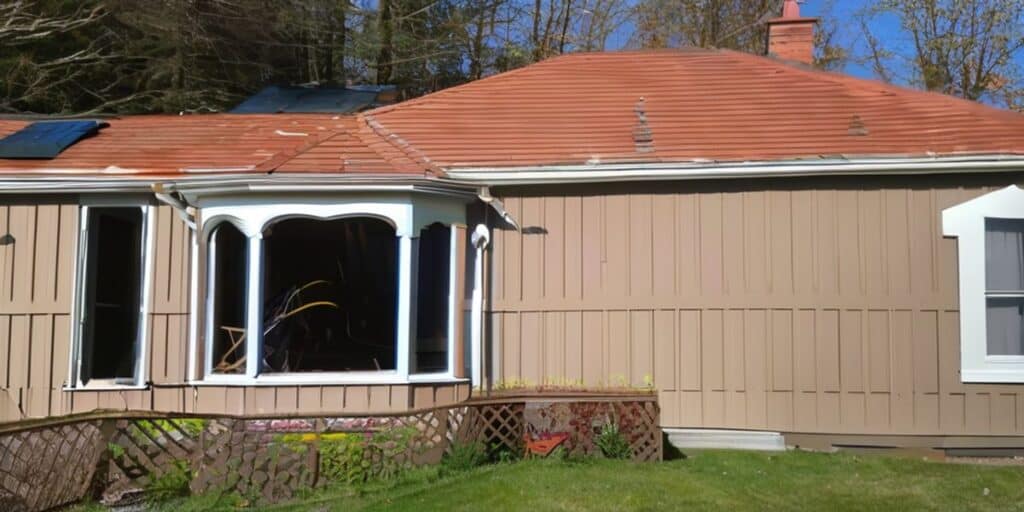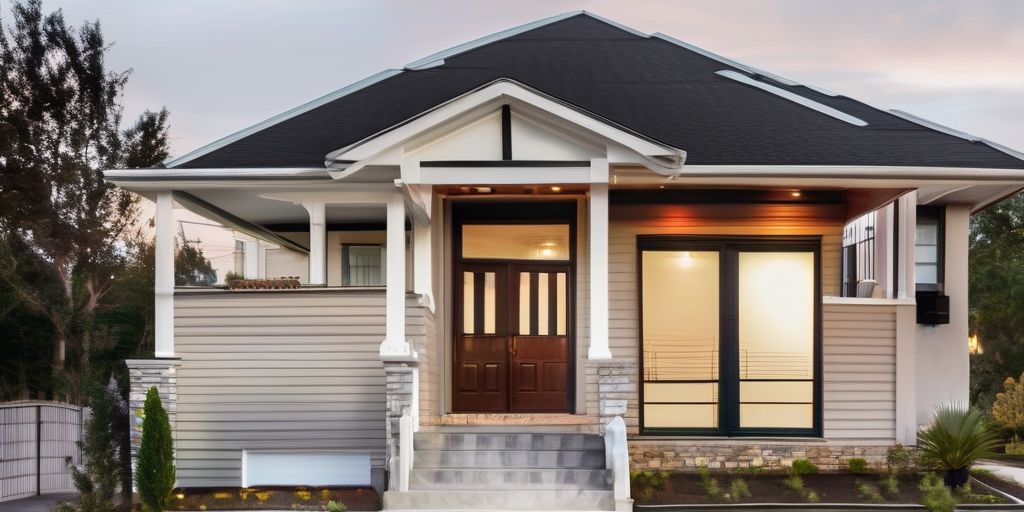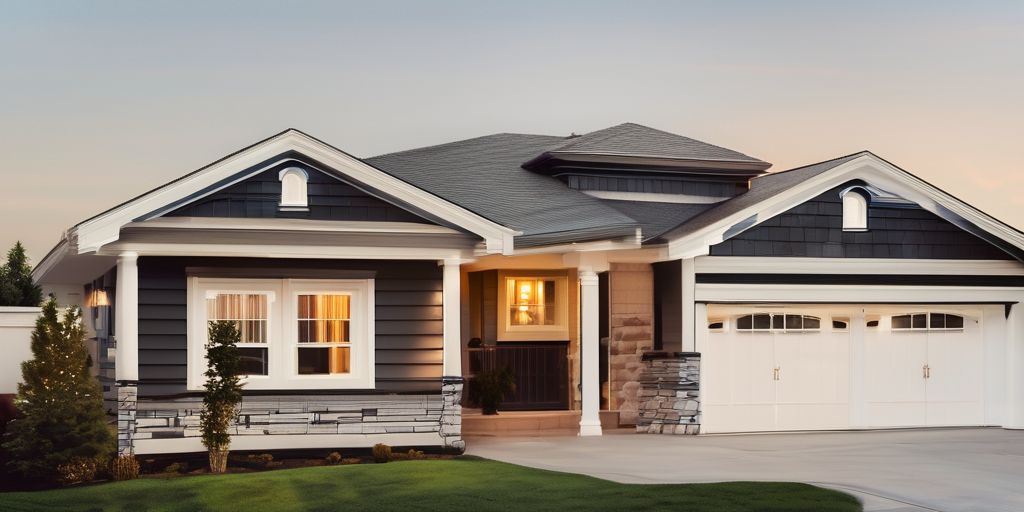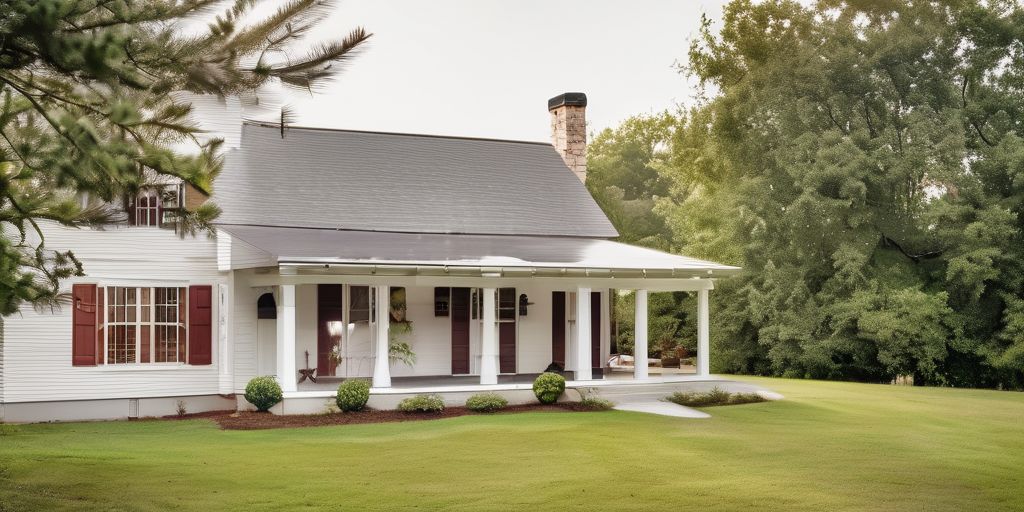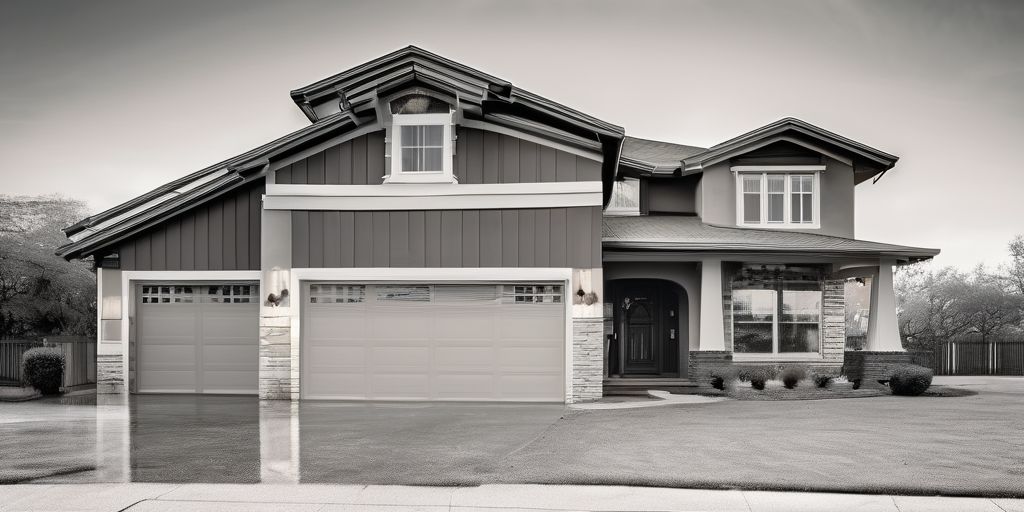Exterior spray painting is a popular method for revamping the appearance of homes in St. Catharines. However, the success of this endeavor hinges significantly on the use of primer. Primer serves as a critical undercoat that ensures the durability, appearance, and longevity of the paint job. This article delves into the multifaceted role of primer in exterior spray painting, offering insights into why it’s indispensable, how to prepare surfaces for primer application, choosing the appropriate primer for different materials, application techniques for a seamless finish, and maintenance tips for preserving the paint over time.
Key Takeaways
- Primer is essential for enhancing paint adhesion, providing durability, and ensuring the longevity of an exterior paint job.
- Surface preparation, including cleaning and scuffing, is critical for optimal primer adhesion, especially for materials like cellular PVC trim and beadboard.
- The choice of primer is influenced by the exterior material, with specific considerations for cellular PVC, fiber cement, vinyl siding, and dark or solar reflective coatings.
- Application techniques, such as using a sprayer for a smooth finish and brushing to fill in grooves, are key to achieving an even and flawless exterior appearance.
- Regular maintenance, including check-ups and touch-ups, coupled with the use of quality primer, can significantly extend the lifespan of an exterior paint job.
Understanding the Importance of Primer in Exterior Spray Painting
The Foundation for Durability: Why Primer Matters
When it comes to exterior spray painting, the use of primer is a critical step that should never be overlooked. Primer serves as the essential foundation that ensures the following benefits:
- Adhesion: Primer provides a surface that paint can firmly stick to, reducing the likelihood of peeling and flaking.
- Protection: It acts as a barrier, protecting the material underneath from moisture, stains, and other environmental factors.
- Efficiency: A primed surface requires fewer coats of paint, saving time and materials.
In St. Catharines, where the weather can be as varied as the beautiful views from Montebello Park, a well-applied primer is key to enduring the elements.
Remember, the right primer can significantly extend the life of your paint job, making it a wise investment for any exterior project.
Always consult the paint manufacturer’s guidelines, as using the correct primer may be a condition of the warranty. Moreover, some primers have limitations on color due to their inherent darkness, which could lead to heat distortion issues if not considered.
Navigating Manufacturer Warranties: The Role of Primer
When selecting the right exterior paint for your St. Catharines home, understanding the warranty provided by the manufacturer is essential. Primer plays a pivotal role in ensuring that the paint adheres properly and lasts as long as promised. Here are some key points to consider:
- Always read the warranty’s fine print to grasp the full extent of coverage.
- Warranties may cover various aspects, from manufacturer defects to color fading.
- The use of primer is often a condition for warranty validity.
Remember, a warranty is only as good as the preparation and products used. Proper priming is a cornerstone of that foundation.
It’s important to follow the manufacturer’s instructions to the letter. This includes using the recommended type of primer, especially when dealing with materials like vinyl siding, which may have specific warranty stipulations. Here’s a quick checklist to help you stay on track:
- Read the warranty details thoroughly.
- Use the specified primer for the material.
- Follow all preparation guidelines.
- Keep records of products used and application methods.
By adhering to these guidelines, you ensure that your paint job is not only beautiful but also protected under the manufacturer’s warranty.
Color Considerations: How Primer Affects Paint Performance
When embarking on an exterior spray painting project, the choice of primer can significantly influence the final appearance and performance of your chosen color. Primer sets the stage for the paint, ensuring that the true hue shines through without being altered by the underlying material.
- Primer acts as a neutral base, especially important when transitioning from a dark to a light color.
- It can improve the vibrancy and depth of the color applied on top.
- Certain primers are designed to work with specific paint colors, enhancing the overall finish.
Remember, a well-chosen primer can make a world of difference in achieving the desired aesthetic and ensuring the longevity of your paint job.
In St. Catharines, where the elements can be harsh, using the right primer is crucial for maintaining the integrity of your home’s exterior. Whether you’re painting near the serene Montebello Park or in the bustling downtown core, the right preparation will ensure your home stands out for all the right reasons.
Preparing Surfaces for Optimal Primer Adhesion
Cleaning and Scuffing: The Key to Primer Efficacy
Before embarking on an exterior spray painting project, it’s crucial to understand that the success of your paint job hinges on the preparation of the surface. Choose cleaning products carefully for surface compatibility and safety. A clean surface ensures that the primer will adhere properly, laying the groundwork for a durable and visually appealing finish.
Thorough sanding and primer application are essential steps in achieving a flawless paint job. Sanding not only helps to clean the surface but also creates a texture that the primer can grip onto. Here’s a simple list to guide you through the process:
- Start with a mild cleaning agent to remove dirt and grime.
- Rinse thoroughly with water to eliminate any residue.
- Lightly scuff the surface with fine-grit sandpaper.
- Wipe down the surface again to remove any sanding dust.
Consider environmental factors in areas like Niagara Falls, where humidity and temperature can affect drying times and the overall quality of the job. It’s important to paint during optimal conditions to ensure the best results.
Remember, a well-prepped surface leads to a paint job that not only looks professional but also withstands the test of time.
The Specifics of Priming Beadboard and Cellular PVC Trim
When it comes to enhancing the exterior of your home, beadboard and cellular PVC trim are popular choices for their durability and aesthetic appeal. Proper preparation and priming are key to ensuring that these materials look great and last long. Here’s what you need to know:
- Cleaning is crucial: Before painting, always clean the trim to remove any dust, dirt, or other contaminants. This ensures that the paint adheres properly and provides a smooth finish.
- Scuff for success: Some cellular PVC trims have a high sheen, which can hinder paint adhesion. Lightly scuffing the surface can improve the paint’s grip, leading to a more durable finish.
- Primer isn’t always necessary: While not always required, using a primer can enhance the finish quality. If you opt for a primer, choose one that’s compatible with the paint you’re using.
Remember, while most cellular PVC trim comes in white and may not need painting, adding a coat of paint can provide that personal touch to match your home’s color scheme. If you decide to paint, using a premium acrylic latex paint with a built-in primer can offer a lasting finish. And, if you’re painting while enjoying the scenic views of the St. Catharines area, like the beautiful Montebello Park, the drying time can double as a perfect break to take in the surroundings.
When painting, always inspect the first coat and apply a second if necessary to achieve a uniform surface. This attention to detail will pay off with a finish that withstands the test of time.
When to Prime: Before or After Installation?
Deciding when to prime during an exterior spray painting project can significantly impact the ease of application and the durability of the finish. Here are some considerations to keep in mind:
- Priming before installation can streamline the painting process, especially for intricate pieces. However, it may require touch-ups post-installation due to handling and fastening.
- Priming after installation ensures a seamless finish and eliminates the need for immediate touch-ups. This approach is particularly beneficial when the final color choice is pending.
It’s essential to adhere to the paint manufacturer’s warranty requirements, which may stipulate the use of a primer. Always check the Light Reflectance Value (LRV) limitations to avoid potential heat distortion issues.
When working with materials like beadboard or cellular PVC trim, consider the following:
- Beadboard panels cover a large area quickly but require careful alignment. Prime after installation to avoid misalignments.
- Cellular PVC trim is best primed after installation to ensure a uniform coat and to accommodate any on-site adjustments.
Remember, choosing the right bonding primer and applying it properly are crucial steps for a long-lasting finish. Always consider the material, spray application, and the environment when selecting a primer.
Choosing the Right Primer for Different Exterior Materials
Best Practices for Painting Cellular PVC Trim
When it comes to enhancing the exterior of your home, painting cellular PVC trim can make a significant impact. Here are some best practices to ensure a successful application:
- Always clean the trim before painting to remove any dust, dirt, or other foreign materials. A pristine surface will ensure better paint adhesion.
- Lightly scuff the surface to improve paint adhesion, especially since cellular PVC can have a high sheen.
- While priming isn’t always necessary, using a premium 100% acrylic latex paint with a built-in primer can greatly enhance the finish quality.
- Be mindful of the paint manufacturer’s warranty, as a primer may be required for coverage.
Remember, the longevity of your paint job on cellular PVC trim is remarkable. With the right paint and preparation, you won’t need to repaint for upwards of 20 to 25 years. Most coatings will be dry to the touch within an hour, allowing for a quick and efficient project completion.
Cellular PVC trim offers a durable and moisture-resistant option for your home’s exterior, ensuring that your chosen color and finish will stand the test of time.
The Special Case of Fiber Cement and Vinyl Siding
When it comes to exterior spray painting, both fiber cement and vinyl siding present unique challenges and opportunities. Fiber cement is known for its durability and premium feel, while vinyl siding is celebrated for its versatility and range of options. Here’s what you need to know to achieve a professional finish:
- Properly protect your surroundings before starting the painting process. This includes covering plants, windows, and other areas that are not to be painted.
- For vinyl siding, it’s crucial to clean the surface thoroughly to ensure good adhesion. Use a mild detergent and rinse well.
- Seal any gaps or cracks with quality caulk to prevent moisture penetration, which can lead to paint failure.
- Choosing the right primer is essential for a durable finish. Look for products specifically designed for use on vinyl or fiber cement.
Patience is key during the application process. Take your time to apply the primer and paint evenly, considering the weather conditions for optimal drying and curing times.
Remember, a well-executed paint job not only enhances the aesthetic appeal of your home but also contributes to its longevity. Whether you’re dealing with the changing climate of Hamilton or the picturesque surroundings of St. Catharines, close to the iconic Welland Canal, the right preparation and application techniques are vital.
Selecting Primers for Dark Colors and Solar Reflective Coatings
When it comes to painting the exterior of your home, choosing the right primer is as crucial as selecting the perfect color. For dark colors and solar reflective coatings, the primer choice can make a significant difference in the performance and longevity of your paint job.
- Always opt for primers that are specifically formulated for dark colors or solar reflective coatings.
- Ensure the primer adheres to the same Light Reflective Value (LRV) guidelines as your chosen paint.
- A high-quality primer will not only improve adhesion but also enhance the paint’s durability against the elements.
Remember, a good primer acts as a protective layer that can extend the life of your paint, especially when dealing with darker shades or reflective materials.
In St. Catharines, where the weather can vary, it’s essential to consider the local climate when selecting your primer. Whether you’re near the historic Welland Canal or in the heart of the city, the right primer will help maintain your home’s curb appeal for years to come.
Application Techniques for a Flawless Finish
Spray Painting vs. Brushing: Achieving a Smooth Finish
When it comes to achieving a smooth finish on your exterior painting project, the method of application can make all the difference. Spray painting is often the go-to choice for its ability to provide an even coat and cover large areas efficiently. Here are some key points to consider:
- Speed & Efficiency: Spray painting is faster than brushing, allowing for quicker coverage of expansive surfaces.
- Even Coverage: A sprayer can deliver a consistent coat, reducing the likelihood of streaks and brush marks.
- Accessibility: It’s easier to reach tricky spots with a sprayer, ensuring a uniform look across all areas.
However, brushing has its own set of advantages, especially when it comes to detail work and grooves that are common in exterior elements. A brush allows for more control in these areas, ensuring that every nook and cranny is properly coated.
For the best results, a combination of both techniques may be employed. Start with spray painting for the broad surfaces and follow up with a brush to fill in the finer details.
Remember, the key to a successful paint job is not just the application but also the preparation. Ensure the surface is clean and properly primed to allow for optimal paint adhesion. In St. Catharines, where the weather can be unpredictable, this step is crucial to withstand the elements over time.
Tips for Even Coverage on Complex Surfaces
Achieving even coverage on complex surfaces requires a methodical approach and attention to detail. Here are some tips to help you get that professional finish:
- Start with the right equipment: Use a high-quality sprayer with adjustable settings to handle the intricacies of complex surfaces.
- Control the overspray: Mask off surrounding areas to protect them from excess paint.
- Calibrate your equipment: Ensure your sprayer is delivering consistent pressure for uniform coverage.
Remember, patience is key. Take your time to cover every nook and cranny for a flawless result.
When dealing with grooves and textures, it’s crucial to apply multiple thin coats rather than one thick coat. This prevents drips and ensures the primer and paint adhere properly to the surface. For St. Catharines’ homeowners, consider the local climate when selecting your paint to ensure durability against the elements.
Dealing with Grooves and Textures in Exterior Elements
When tackling the challenge of spray painting grooves and textures, it’s essential to approach the task with precision and patience. These exterior elements can be particularly unforgiving, but with the right techniques, a flawless finish is within reach.
- Preparation: Ensure that all surfaces are clean and dry. Dirt and moisture can compromise the adhesion of both primer and paint.
- Technique: Use a consistent spray pattern and maintain a steady hand. Overlap each pass slightly to avoid missed spots.
- Angle: Adjust the angle of your sprayer to get into deep grooves and ensure even coverage.
Remember, the goal is to achieve a uniform coat that enhances the beauty and character of your home’s exterior.
In St. Catharines, where the climate can be as varied as the architecture, selecting the right primer and paint for your specific material is crucial. Whether you’re working on a charming Victorian with intricate woodwork or a modern home with sleek fiber cement panels, the principles remain the same. For a touch of local flair, consider colors that complement the natural beauty of landmarks like the historic Welland Canal.
Maintaining Your Exterior Paint Job Over Time
The Impact of Quality Primer on Longevity
The longevity of an exterior paint job is significantly influenced by the initial application of primer. High-quality primer acts as a crucial barrier, protecting the paint from the elements and ensuring that the topcoat adheres properly. Here are some key points to consider:
- Primer provides a uniform surface for the topcoat, enhancing paint adhesion and reducing the likelihood of peeling or blistering.
- It seals porous surfaces, preventing moisture from seeping through and causing damage.
- A good primer can improve the efficiency of paint coverage, potentially reducing the amount of paint needed for the job.
When considering the long-term appearance and protection of your home’s exterior, never underestimate the power of a well-applied primer.
In St. Catharines, where weather can range from icy winters to humid summers, a robust primer is especially important to withstand the changing conditions. Whether you’re painting near the historic Welland Canal or a suburban neighborhood, the right primer will contribute to the endurance and vibrancy of your paint job.
Regular Check-ups and Touch-ups: Keeping Your Exterior Pristine
To ensure the longevity and beauty of your exterior paint job, regular maintenance is key. Maintain aluminum siding by cleaning, inspecting, and touching up regularly. This not only preserves the aesthetic appeal but also the structural integrity of your home. Considering the local climate is crucial when planning maintenance schedules, as St. Catharines’ weather can influence the wear and tear on your home’s exterior.
italics should be aware of the importance of choosing high-quality paint for both durability and aesthetic appeal. This investment upfront can save time and money in the long run by reducing the frequency of required touch-ups.
Proactive maintenance, including regular check-ups, can prevent minor issues from becoming major problems. It’s the smart approach to keeping your home looking its best.
Here are some simple steps to keep your exterior pristine:
- Schedule regular cleaning to remove dirt and grime.
- Inspect for any signs of damage or wear.
- Touch up paint as needed to protect surfaces.
- Consider the impact of the local climate on your maintenance plan.
Understanding the Lifespan of Different Paint and Primer Combinations
When it comes to maintaining the aesthetic appeal and structural integrity of your home’s exterior, choosing the right paint and primer combination is essential. The lifespan of your paint job is not just about the quality of the paint itself, but also how well the primer adheres to the surface and supports the topcoat.
- Primer acts as a protective layer that ensures better paint adhesion and durability.
- Selecting a primer that complements the paint can significantly extend the lifespan of the job.
- Regular maintenance, including cleaning and touch-ups, can preserve the paint’s appearance and protective qualities.
In St. Catharines, where the weather can be unpredictable, it’s important to choose weather-resistant and eco-friendly coatings. These products are designed to withstand the local climate and environmental impacts, ensuring that your home looks great for years to come.
By prioritizing surface preparation and leveraging local knowledge, homeowners can achieve a successful exterior spray painting project that stands the test of time.
Remember, engaging professional painters who understand the specific needs of different materials and the local environment can make all the difference in the longevity and quality of your exterior paint job.
Ensuring the longevity of your exterior paint job is crucial for maintaining the beauty and value of your home. At We Paint Siding, we specialize in providing high-quality finishes for aluminum and vinyl siding, offering a cost-effective alternative to replacement. Our expert painters have over 20 years of experience transforming homes with durable and aesthetically pleasing solutions. Don’t settle for a worn-out look or unnecessary expenses; visit our website to learn more about our services and book a free estimate today. Let us rejuvenate your home’s exterior with our proven techniques and 10-Year Guarantee.
Conclusion
In conclusion, the success of exterior spray painting in St. Catharines hinges on meticulous preparation and the strategic use of primer. Whether you’re working with beadboard, cellular PVC trim, or fiber cement products, the right primer can make all the difference in durability and aesthetic appeal. By following manufacturer instructions for both paint and primer, and opting for high-quality products, you can achieve a finish that not only looks professional but also withstands the test of time. Remember, a well-executed paint job not only enhances the beauty of a home but also serves as a protective layer against the elements. So take the time to do it right, and your work will be admired for years to come.
Frequently Asked Questions
Why is primer important for exterior spray painting?
Primer is essential for exterior spray painting as it serves as the foundation for durability. It ensures better adhesion of paint to the surface, enhances paint performance, and can be a requirement for paint manufacturer warranties.
Should I clean and scuff the surface before applying primer?
Yes, cleaning and lightly scuffing the surface are crucial steps to ensure primer efficacy. This process removes dust, dirt, and other foreign materials, and creates a texture that helps improve paint adhesion.
Is it necessary to prime cellular PVC trim before painting?
Priming cellular PVC trim isn’t necessary if you use a premium 100% acrylic latex paint with a built-in primer. However, using a primer can enhance the finish quality and may be required for the paint manufacturer’s warranty.
How do I select the right primer for dark colors and solar reflective coatings?
For dark colors with a light reflective value (LRV) of 56 or lower, it’s crucial to choose an approved solar reflective coating to prevent heat distortion. Always follow the paint manufacturer’s instructions for the best results.
What’s the best way to apply primer for a smooth finish?
Using a paint sprayer can create a smooth finish and cover surfaces quickly. However, you may need to use a brush to fill in grooves and textures, ensuring even coverage and a flawless finish.
How does primer affect the longevity of an exterior paint job?
A high-quality primer can significantly impact the longevity of an exterior paint job by improving adhesion, resisting weathering, and providing a stable foundation for the topcoat, which can extend the life of the paint.

